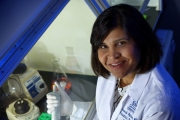Posted on December 19, 2013
Source: Nature

DEBORAH PERSAUD: Viral victor
A virologist provides the strongest evidence yet that infants born with HIV can be cured.
By Sara Reardon
In March, Deborah Persaud was ready to share the news: a baby born with HIV in Mississippi seemed to be virus-free nearly a year after stopping treatment. Persaud, a serious, soft-spoken virologist at Johns Hopkins Children’s Center in Baltimore, Maryland, says she knew that she had to tread delicately. More than 40 similar cases had previously been reported in the literature, and each had fallen apart on closer scrutiny. Genetic analysis revealed that most of the initial tests had generated false positives or had involved specimen mix-ups.
But Persaud and her collaborators, Hannah Gay at the University of Mississippi in Jackson and Katherine Luzuriaga of the University of Massachusetts in Worcester, had done the genetic tests on the Mississippi baby themselves and were ready for the critics. What they were not expecting was the media onslaught that followed their announcement. News outlets around the world jumped on the story, and after a month the three were listed among Time magazine’s 100 most influential people in the world.
Persaud’s role in the case started with a call in September 2012 from Gay, a paediatrician, who was treating a baby born to a woman with HIV. Because the mother had gone untreated for the duration of her pregnancy, Gay gave the baby high doses of three antiretroviral drugs — zidovudine, lamivudine and nevirapine — within hours of birth. Tests conducted at the time showed that the baby had HIV, and the mother was told to continue the child on treatment. At one check-up, however, Gay found that the baby had not been getting her drugs for five months. Gay tested the child and found no sign of the virus.
To make sure that this was not another false signal, Gay called in Persaud and Luzuriaga. They matched the mother’s DNA with the baby’s to be sure that she had not been switched in the hospital. They took five separate blood samples for the HIV tests and personally checked each lab result. As they ruled out alternative explanations, it looked more and more likely that the initial blast of drugs had wiped out the virus. They published a paper describing the case in November (D. Persaud et al. N. Engl. J. Med. 369, 1828–1835; 2013), and so far it seems to be standing up to scrutiny.